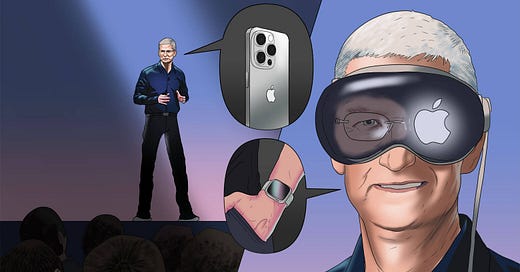You can listen to a professional narration of this article below:
A Story about a Story
Apple is the best storytelling company on the planet. This was the thought that ran through my mind as I watched Apple present its new products at the WWDC conference.
When it introduces a product, Apple doesn't just spend the time telling you what it will do for you; it directs as much effort to telling a very detailed story about how it made the product. Here is an excerpt from the introduction of the Apple Watch:
Our engineers have custom-designed a new alloy that is 60% stronger than standard alloys but just as light. This requires precision alloying. Raw aluminum of exceptional purity is first heated to a molten state, and tightly controlled amounts of magnesium and zinc are then added.... Next, a finely tuned extrusion process creates a uniform surface free of defects. After being meticulously formed, each case is machined, buffed and then textured with microscopic zirconia beads to achieve a consistent satin finish...”
And that’s just the Apple Watch case! This is a tiny except where Apple tells you a story about how much soul they put into making each little component of their product, explaining the process in technical terms the average human being doesn't understand.
But at the same time giving comfort because the tech-speak is interlaced with over-the-top adjectives that make you feel that only Apple can care so much about creating such incredible products.
In its storytelling, Apple so wants you to fall in love and have an emotional connection with its product that it even names the parts that go into it: Its display is “Retina.” Do you know the name of the display of your Dell laptop? I honestly don't know if Apple's display is any better or different than Dell's; it could be even identical to Dell's – probably made in the same Sony factory.
But since it has a name, Retina, and Apple spent five minutes talking about the precision with which it's made, you feel like it's worlds better than Dell's XKBS6N display (I made this one up). Apple doesn't stop with the components that go into its computers. Its keyboard is called “Magic.” Software which only Apple users can use to call each other is called “Facetime,” which is actually a verb now.
I am not mocking Apple; quite the contrary. I want to emphasize the importance of storytelling in the company’s communications. Apple made us fall in love with its gadgets by creating or reimagining new categories of products, then by making incredibly desirable devices, and by being obsessed with quality and ease of use. But it cemented this love through storytelling – an essential element of Apple's success.
Storytelling is one thing that separates humans from other animals. It is not just important in marketing a product; smart management uses a story to align what it does with the expectations of shareholders. Jeff Bezos used to bring on board shareholders who would align with his vision. Storytelling allowed Amazon to not turn a profit for decades, as it was reinvesting its money into yet to be profitable products.
A story is what provides cohesion among employees and influences corporate culture. If employees are only motivated by their paycheck and free meals to come to work, a competitor that offers a pay bump and better food will win them over. It is more difficult to replace a good story; the employee has already made an emotional investment in it, and there is an emotional sunk cost. A good story embeds itself in our hearts and gives a meaning to our life.
However, just like a joke is only funny when there is a kernel of truth in it, the story must have a foundation based on truth in order to be effective. I can’t stress this point enough. A story can obfuscate the truth for only so long; it will eventually come out. If Apple had told you about the precision of its craftsmanship and your Apple Watch case had rough edges that were cutting your wrist, the story Apple told you would quickly be contradicted.
A powerful, well communicated story that is aligned with one’s identity (be it company, a product or a person) is an incredible tailwind on a journey to success.

Manfred
Today, I would like to share with you the Manfred Symphony by Pyotr Ilyich Tchaikovsky. If you had asked me a month ago how many symphonies Tchaikovsky composed, I would have answered with a straight face: six! Number Six was his final one, which he conducted days before his death.
However, I recently discovered that he had actually composed seven symphonies: The Manfred Symphony (also known as a tonal poem) was composed after the fourth symphony. Unlike his other symphonies, it is a program symphony based on the poem Manfred by Lord Byron, in which the music attempts to tell a literal story.
I love writing about Tchaikovsky for many reasons. I love his music; he is one of my favorite composers. His music is electrifying, powerful, full of incredible melodies, and super-packed with emotional content that deeply resonates with me.
But there is another reason I love writing about his music: Tchaikovsky wrote a lot of letters. Music was his life, his one and only love, and he wrote about it extensively to his friends and to his benefactor, Nadezhda von Meck, a wealthy woman who loved Tchaikovsky's music. Reading these letters is as close as one can get to reading the private diary and thus getting an intimate look at the creative process of this genius.
Through these letters, I appreciated the emotional roller coaster Tchaikovsky rode while composing his timeless music. As a creator, I found that energizing. No, I don't take joy from others’ suffering. But as a writer, I can relate to the emotional highs and lows experienced by Tchaikovsky.
Let me provide you with context on how the Manfred Symphony came about. The Russian music critic Vladimir Stasov suggested to both Russian nationalist composer Mily Balakirev and French composer Hector Berlioz that they write a symphony based on Lord Byron's Manfred. Berlioz had created and popularized the program symphony genre with his Symphonie Fantastique. Both composers declined the suggestion, but Balakirev proposed the project to Tchaikovsky. Initially, Tchaikovsky was hesitant, as he was enamored with Robert Schumann's overture on Manfred and did not believe he could compose something better.
In October 1884, he writes to Balakirev:
I set about Manfred rather reluctantly and, if I may be frank, felt that I was obliged to write it, because I promised you, and I made a firm promise... but very soon I became terribly infatuated with Manfred, and cannot remember ever having felt such pleasure in working, which stayed with me until the end.
We often look for inspiration to come to us, as if an external muse were paying us a visit. However, inspiration comes from within us. It comes through our act of sitting down and working, whether we are composing, like Tchaikovsky, or writing, as I do.
In July 1885 Tchaikovsky writes this:
I completed the rough sketches for a symphony, which annoys me a great deal, and I feel the need to rid myself of it as soon as possible.
I can relate to this feeling so much. I get impregnated with an idea, and I don't feel at ease until I let it out on paper. Creating is a nonlinear process; and thus, during this idea pregnancy, I am full of conflicting emotions fluctuating between frustration and joy. I am often not fun to be around during this time. Though the creative process of giving birth to a piece of writing is often painful, once I am done with it, I often experience joy and incredible creative satisfaction.
A month later, in August 1885, Tchaikovsky writes:
I set about making the sketches for this symphony, and became so carried away, as frequently happens, that I could not stop. The symphony has come out enormous, serious and difficult; it is absorbing all my time, and sometimes wearies me in the extreme; but an inner voice tells me that I am not laboring in vain, and that this will be, perhaps, the best of my symphonic compositions.
Nobody complains better than Tchaikovsky. He writes to Nadezhda Van Meck at about the same time:
I am working on a very difficult, complicated symphonic work (on the subject of Byron's Manfred), which happens to have such a tragic character, that occasionally I turn into something of a Manfred myself. That apart, I am having to squeeze out every last drop of effort from myself. I want so much to quickly bring this to an end, and am using up all my strength... as a result of this, I am absolutely exhausted.
He also tells his brother:
Never before have I expended such labor and exertion as on the symphony that I am now writing.
Just a few weeks later, Tchaikovsky is full of joy and incredibly proud of his work:
It is my opinion that my symphony will be the best of all my compositions in symphonic form... I am very proud of this work, and want those persons whose sympathy I most value in the world... to experience, when they hear it, a reverberation from the enthusiasm with which I wrote it.
As much as the creative process is a deeply personal endeavor, we creators want people to love what we make. Of course, this is very dangerous, because that is something that is not under our control. When the Manfred Symphony was performed in March 1886, it was met by a very cool reception from the audience.
But Tchaikovsky was very proud of this symphony. In March 1886 he writes:
I am very pleased with myself. I think that this is my best symphonic work. It was performed excellently, but it seemed to me that the public had little concept of it and received it rather coolly, although at the end I was given an ovation.
However, his love for this piece did not last long. In October 1888 he writes:
As for Manfred, without any wish to make a mere show of modesty, I would like to say that it is an abominable piece, and that I loathe it deeply, with the exception of the first movement alone… with the agreement of my publisher, I shall destroy completely the remaining three movements, which musically are very poor (the Finale is particularly loathsome), and out of a large, impossibly long symphony…
Though the first movement is my favorite too, thankfully this symphony was not destroyed by the publisher. It is Tchaikovsky’s longest symphony and requires a large orchestra and thus is not performed as often as his other, more popular symphonies.
Vitaliy Katsenelson is the CEO at IMA, a value investing firm in Denver. He has written two books on investing, which were published by John Wiley & Sons and have been translated into eight languages. Soul in the Game: The Art of a Meaningful Life (Harriman House, 2022) is his first non-investing book. You can get unpublished bonus chapters by forwarding your purchase receipt to bonus@soulinthegame.net.
Please read the following important disclosure here.





thank you!
You should check out this course by Robert Greenberg. https://www.thegreatcourses.com/courses/great-masters-tchaikovsky-his-life-and-music
I think Greenberg is a wonderfully entertaining lecturer.
Budapest airport is named for Liszt. Warsaw for Chopin. No such honor for tchaikovsky just yet!